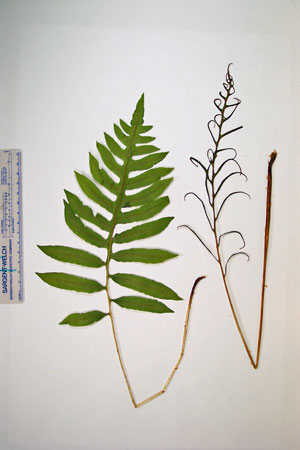DACF Home → Bureaus & Programs → Maine Natural Areas Program → Communities, Plants, and Animals → Rare Plants → Woodwardia areolata

Woodwardia areolata (L.) T. Moore
Netted Chain Fern
- State Rank: SH
- Global Rank: G5
- State Status: Possibly Extirpated
Habitat: Acid peat, boggy woods, swamps. [Forested wetland]
Range: Florida to Texas, north on coastal plain to southern Maine: disjunct in Nova Scotia. Possibly extirpated - last collected in 1917. Considered rare in New Hampshire but not southward.
Aids to Identification: Woodwardia is called chain fern because of the venation seen on the back of the leaves forming a distinctive chain-like pattern up the midrib of the leaf. W. virginica, Virginia chain fern, is not uncommon in certain wetlands of southern Maine. W. areolata, on the other hand, has not been confirmed from Maine in decades. It differs from W. virginica in having dimorphic leaves: the sterile leaves are deeply cut and have fewer segments or leaflets (7-19 pairs) than W. virginica (15-20 pairs), while the fertile leaves, which stand taller than the sterile, have a black petiole and narrowly linear leaflets. Of the Maine ferns, vegetative W. areolata may most closely resemble (though only superficially) the ubiquitous sensitive fern (Onoclea sensibilis), but sensitive fern will have more wavy-margined segments and, of course, lacks the characteristic chain-like venation on the back of the leaf.
Ecological characteristics: Not known for Maine.
Phenology: Reproductive phenology not known for Maine; vegetatively identifiable throughout the growing season.
Family: Blechnaceae
Synonyms: Lorinseria areolata (L.) K. Presl, nom. illeg.; Woodwardia onocleoides Willd.
Known Distribution in Maine: This rare plant has historically been documented from a total of 3 town(s) in the following county(ies): Knox, Oxford, York.
Reason(s) for rarity: At northern limit of range.
Conservation considerations: Unknown; no current locations for this species are documented.